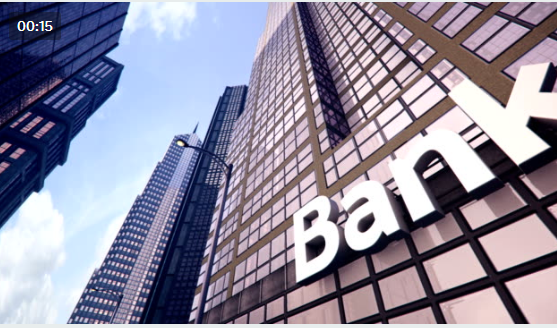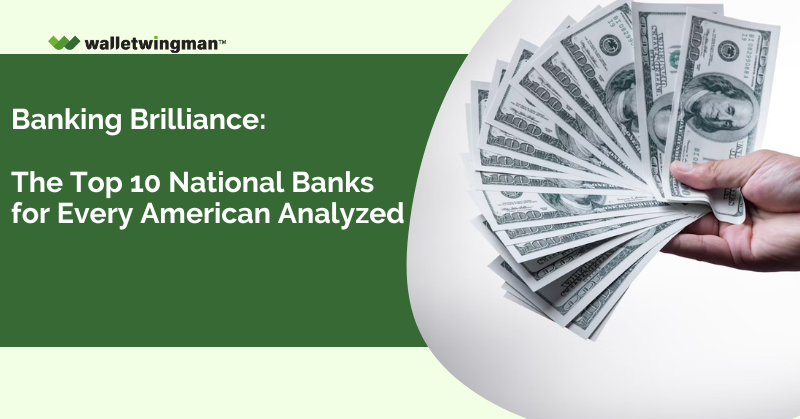Finding the right financial institution that satisfies your requirements can feel like searching for a needle in a haystack. The American banking industry offers thousands of options between massive countrywide banks, regional players, and local credit unions. With so many selections available, how can you identify the ideal banks for your unique monetary circumstances?
This definitive guide accomplishes your legwork by ranking the best national banks. It condenses the entire banking sector to the elite establishments that provide factors like customer assistance, digital experiences, competitive account proposals, branch access, and more.
But first things first, let us look at what you should consider when choosing a bank.

What Should You Consider When Choosing a Bank?
Choosing the right bank requires a thoughtful evaluation across key factors to find an ideal match. Consider the bank’s accessibility – convenient in-person banking demonstrates banking brilliance, review account options to ensure they suit your financial lifestyle and analyze fee structures to avoid surprises.
Prioritize banks with exceptional customer service and digital platforms, simplifying finances through online access, mobile apps, and 24/7 assistance. Moreover, look for top-rated national banks with a proven history of safely and smartly managing client finances.
Carefully comparing contenders across these pivotal categories will reveal the banks excelling at combining personalized care, robust technology, and capabilities into one brilliant client experience. Taking the time to evaluate these critical factors will guide you to the top 10 banking institutions as discussed below:
1. Chase
Chase consistently comes out at the helm of top national banks for their stellar customer service, competitive products, extensive ATM network, and leading digital tools. For an all-around excellent banking experience, Chase can’t be beat. The convenience, rewards, and digital experience shine. But fees, credit limits, and community impact are weaknesses.
Here’s a closer look at what makes them number one in the national bank rankings:
Pros
- Over 4,800 branches and 16,000 ATMs for unmatched convenience
- Earn rewards and cashback with popular credit cards like the Chase Sapphire and Freedom cards. This bank offers some of the most lucrative credit card rewards programs. From dining and travel perks with the Sapphire cards to revolving bonus categories on Freedom, you can maximize points and savings.
- Industry-leading mobile and online banking app with deposit checks, pay bills, transfer money, etc.
- Over 100 locations with dedicated advisors for personalized wealth management
- Chase First banking – a bank account for kids to help them learn about spending and saving money.
- Has one of the best banking apps with a referral bonus – Chase customers can earn $200 cash for each successful referral and up to $2,000 total per year.
Cons
- You must pay a monthly fee unless you maintain a minimum balance or recurring direct deposits
- Credit card limits may be lower than competitors
- Fewer community development initiatives than smaller banks
2. Bank of America
As another large national brand on the list of top 10 banks, Bank of America is Chase’s biggest competitor. Bank of America edges out Chase regarding accessibility with Spanish-language services. But their fees, rates, and in-person support aren’t as strong.
Here are some of their notable features:
Pros
- Over 4,300 branch locations and 16,800 ATMs for access nationwide
- Standout mobile banking app that’s user-friendly and packed with features
- Preferred Rewards program offers boosted rewards rates and discounts. Customers with qualifying balances can enroll in their Preferred Rewards tiers to earn extra boosts on credit card rewards, higher savings rates, and account fee waivers.
- Extensive Spanish-language support services
Cons
- Monthly fees unless you have recurring direct deposits and maintain a balance
- Lower interest rates on CDs and savings accounts
- Mixed reviews on customer service after branch visits

3. Wells Fargo
With roots on the West Coast and a significant market share nationwide, Wells Fargo has cemented itself as one of the leading national banks. Wells Fargo has an advantage by not charging monthly fees. But lingering impacts from scandals plus below-par digital experiences are downsides. However, it’s still a solid option.
Here’s an overview:
Pros
- Nearly 5,000 branches and over 13,000 ATMs for a broad presence
- User-friendly mobile and online banking with mobile deposit
- No monthly fees or balance requirements to avoid fees
- Standout mortgage and home equity products
Cons
- Ongoing impacts from the fake account scandal have hurt reputation
- Online and mobile experiences lag behind some competitors
- Lower interest rates on deposit accounts
4. Citi
Multinational Citi has established itself domestically with U.S. headquarters in New York. They cater exceptionally well to urban markets. For city dwellers who value digital convenience, Citi hits the mark with its mobile app and urban branches. However, rural customers may struggle with access, and their website falls short.
Pros
- More than 700 branches with a significant presence in large metro markets
- Top-rated mobile banking app with advanced features
- No monthly fees or balance requirements to waive fees
- Leading credit card rewards, benefits, and sign-up bonuses
Cons
- Limited branch presence in rural areas
- Website and online account management are lackluster compared to mobile
- Lower interest rates on savings accounts and CDs
5. U.S. Bank
With roots on the West Coast and Midwest, U.S. Bank has expanded nationwide while retaining that regional feel. The U.S. Bank matches the leading national banks regarding fee-free checking and savings rates. Their customer service focus and regional roots are distinguishing factors. But mobile banking and credit cards aren’t as strong.
Here’s what they offer:
Pros
- Decent branch presence with over 3,000 locations nationwide
- No monthly fees or balance requirements to waive fees
- Competitive interest rates on savings and CDs
- Standout customer service compared to other large banks
Cons
- Mobile and online banking lack features offered by more prominent players
- Credit card rewards and benefits trail some competitors
- Limited to no international services

6. PNC
Pittsburgh-based PNC has expanded beyond PA to offer accessible banking up and down the East Coast and beyond. PNC stands out for East Coast residents looking for great rates, virtual wallets, and vital customer service. But it’s probably not the best fit if you live outside the Eastern U.S.
Here’s a quick look:
Pros
- Widespread ATMs and over 2,200 branches across the Eastern U.S
- Standout virtual wallet account helps avoid fees and optimize spending
- Excellent customer service compared to other national players
- Higher interest rates on CDs and savings than most prominent banks
Cons
- There is minimal presence west of Illinois, so it is not ideal for central or western U.S.
- Mobile deposit is only available on iPhones currently
- Monthly fees unless you maintain a balance
7. TD Bank
Originally from Canada, TD Bank has succeeded in becoming one of the top-rated national banks on the East Coast. TD Bank is ideal for East Coasters looking for convenience. But all the locations outside the Eastern seaboard and just functional digital tools are negatives.
Here’s an overview:
Pros
- Concentrated locations across the Eastern U.S. with 1,250+ branches
- Above-average interest rates on savings accounts and CDs
- Standout convenience features like 7-day branch hours
- Range of account options from student to premium
Cons
- Only functional mobile and online banking app
- Primarily located only on the East Coast
- Monthly fees unless recurring direct deposits
8. Capital One
Previously known for credit cards, Capital One has expanded into full-service banking nationwide. Technology-savvy consumers will appreciate Capital One’s stellar mobile app and digital tools. However, limited branches and mixed customer service are downsides.
Here are some highlights:
Pros
- Top-rated mobile and online banking app with advanced tools
- No fees or minimum balances to earn waived monthly fees
- Popular rewards checking and savings accounts
- Standout auto financing rates and options
Cons
- Limited branch locations with under 500 nationwide
- Mixed reviews of customer service after in-person visits
- Savings account rates are lower than online banks
9. Ally Bank
Ally Bank focuses on online banking, so it’s light on the branches. It is perfect for digital-first users seeking higher rates. But if you want in-person banking and international services, it’s not the best choice.
Pros
- Robust online and mobile tools for banking and investments
- No monthly fees or balance requirements
- Consistently higher interest rates on savings and CDs
- 24/7 live customer service support is convenient
Cons
- No branch locations for in-person banking
- Limited to no international services
- Smaller bank, so fewer product options

10. Discover Bank
You may know Discover for their credit cards and rewards, but they also have competitive online banking. Discover Bank matches Ally Bank for digital convenience, fees, and rates. However, a notable downside is the lack of widespread ATM access and branches
Here’s an overview:
Pros
- Well-developed online and mobile banking tools
- No monthly fees or balance requirements
- Solid interest rates on savings, checking, money markets, and CDs
- Up to $150 account opening bonus available
Cons
- No branch network – online only
- Limited ATM network for withdrawals and deposits
- Smaller banks so fewer product offerings
- No international services
Summary
When it comes to the best banks in the US, heavy hitters like Chase, Bank of America, Wells Fargo, and Citi lead the pack when branch access is paramount. Their thousands of locations make them a go-to for convenient in-person banking.
Regional players like PNC, TD Bank, and U.S. Bank are alternatives with more focused branch locations. Their solid regional presence and competitive features make them ideal for customers concentrated in their footprint.
And digitally-savvy consumers can benefit from online banks like Ally Bank and Discover Bank thanks to robust online tools, lack of fees, and solid rates. Their online-first approach appeals to mobile users seeking simplicity.
No matter your priority – from extensive branches and ATMs to sophisticated mobile banking and top rates – a fantastic national bank is ready to meet your needs. Hopefully, this detailed ranking has given you a helpful jumping-off point to find your ideal financial match!


